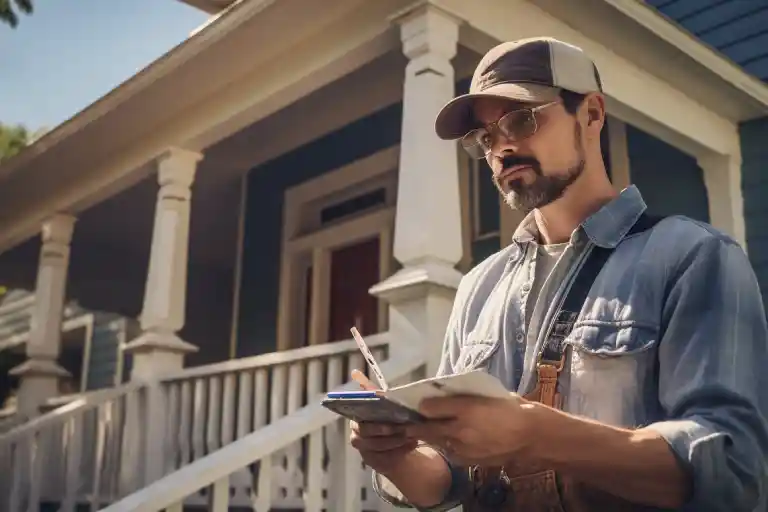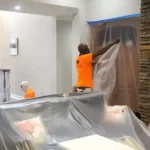How to Estimate Exterior House Painting: 6 Things to Consider
Embarking on an exterior house painting project demands careful consideration of various factors to ensure a successful and cost-effective endeavor. Whether revitalizing the appearance of your residence or ensuring its protection against the elements, estimating the costs involved is a crucial initial step.
Assess the surface condition that needs painting, as this will determine the prep work required. Calculate the square footage of the area to be painted, which determines how much paint is needed. Also, consider the quality of the paint selected and any regional pricing dynamics to get an accurate estimate.
Here, we will discuss the process of estimating the cost of exterior house painting in detail. To estimate the cost accurately, we will assess the surfaces, calculate square footage, analyze regional pricing dynamics and more.
How to Estimate Exterior House Painting: Major Factors to Consider

A house’s exterior often needs painting, so determining the right contractor for the job requires an accurate estimate of the cost and materials needed. To estimate the cost of exterior house painting, there are several key points to consider.
- Surface condition assessment
- Square footage calculation
- Quality of paint selection
- Regional pricing dynamics
- Industry trends and material costs
- DIY and professional considerations
No 01: Surface Condition Assessment
Before calculating the cost of exterior house painting, you need to assess the surface condition using a thorough inspection. This step allows you to identify any existing damage, cracks, or peeling paint that may require additional preparation work.
Look for signs of water damage, mold, or mildew, as these issues must be addressed before painting can begin. Also, check for loose or damaged siding, trim, or fascia boards that must be repaired or replaced.
Taking the time to assess the surface condition will ensure that your estimate is comprehensive and that the final result is a well-painted and long-lasting exterior.
No 02: Square Footage Calculation
To estimate the total square footage, measure the main walls and any additional features like trim, doors, and windows. Be meticulous in measuring hard-to-reach areas, slopes, and uneven surfaces, as these may require additional paint and labor.
You should add a 10% to 50% buffer to the total square footage to accommodate these complexities in the estimation.
No 03: Quality of Paint Selection
Opting for a higher quality paint may come with a higher price, but it’s worth the investment in the long run.
High-quality paints are formulated to withstand the harsh elements and environmental conditions that your exterior surfaces will be exposed to. They provide better protection against fading, chipping, and peeling, ensuring your paint job stays fresh and vibrant for years.
When selecting paint, consider factors such as the paint finish, such as flat, eggshell, satin, semi-gloss, or high-gloss, based on the specific requirements of your surfaces.
No 04: Regional Pricing Dynamics
Painting costs can vary significantly depending on where you live. Factors such as labor rates, material costs, and local regulations can all play a role in determining the overall price.
By understanding the specific dynamics of your region, you can obtain accurate quotes and avoid unexpected cost variations during the painting process. Different areas may have different standards and requirements, impacting pricing.
Also, supply and demand in your region can influence pricing. These regional pricing dynamics will help you determine the exterior house painting cost more accurately.
No 05: Industry Trends and Material Costs
To accurately estimate the cost of exterior house painting, you must stay informed about industry trends and track material costs to account for any fluctuations. Recent paint shortages have caused material prices to increase significantly, ranging from 10% to 30%.
By staying up-to-date with industry trends, you can make more accurate cost projections and ensure that your estimate reflects the current market conditions. This knowledge will help you avoid unexpected budgetary surprises and give you a more reliable estimate.
Also, tracking material costs allows you to adjust your pricing accordingly, ensuring you aren’t undercharging or overcharging your services. Keeping a close eye on industry trends and material costs is essential for effectively estimating the cost of exterior house painting.
No 06: DIY and Professional Considerations
Doing the painting yourself can save you money on labor costs, but it requires significant time and effort. You must have the skills and expertise to ensure a quality outcome.
In contrast, hiring professional painting services ensures a high-quality finish but comes with a slightly higher price tag. Professionals have the experienced labor, tools, and knowledge to handle the job efficiently and effectively.
To estimate the labor rates for preparation work in interior house painting or exterior painting, you must carefully assess your project’s specific requirements. Factors such as lead paint containment, wood replacement, and extensive surface preparation can significantly impact the labor needed.
Ensure that you consider the condition of the existing surfaces and any necessary repairs or priming that may be required. Also, look at the project’s size and complexity, as larger homes might require more labor, which drives up the rate for professional painting contractors.
How do I calculate how much paint I need outside my house?

Calculate the amount of paint you need before prep work for interior house painting or exterior painting by calculating the area’s total square footage (sq. ft.).
Measure the height and width of each wall and multiply them together to get the square footage of each wall. You can calculate the total square footage of the room by adding up all the walls’ square footage.
Once you have the square footage, use a gallon per 300 or 400 sq. ft. You may need to use a specific amount of paint for certain paint formulas and wall textures.
Make Your Home Exterior Look Great Within Your Budget
Estimating exterior house painting requires careful calculations and attention to detail. You can ensure a successful painting project by accurately measuring the surface area, determining the number of coats needed, and considering the type of paint.
With these factors in mind and professional advice when necessary, you can confidently embark on your painting projects and ensure a durable, long-lasting result.
AR Professional Painting Service is a team of experienced, professional exterior painters in Victoria, Australia. We offer competitive rates and excellent customer service.
You can contact us on 0478 056 572 or email info@arprofessionalpainting.com.au to discuss your painting project and receive a free quote. With us, you can be sure your house will look its best with the highest quality paint job.


 Previous Post
Previous Post Next Post
Next Post